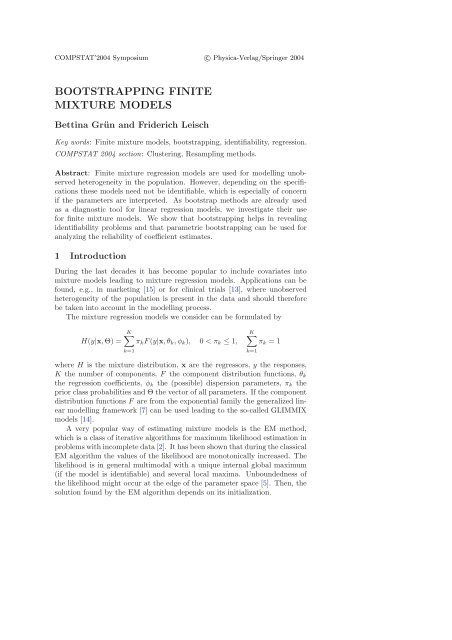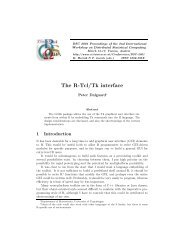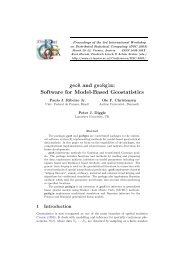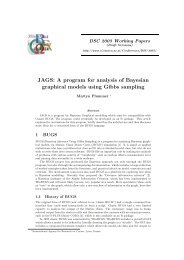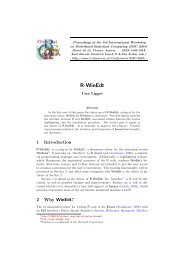BOOTSTRAPPING FINITE MIXTURE MODELS
BOOTSTRAPPING FINITE MIXTURE MODELS
BOOTSTRAPPING FINITE MIXTURE MODELS
You also want an ePaper? Increase the reach of your titles
YUMPU automatically turns print PDFs into web optimized ePapers that Google loves.
COMPSTAT’2004 Symposium ○c Physica-Verlag/Springer 2004<strong>BOOTSTRAPPING</strong> <strong>FINITE</strong><strong>MIXTURE</strong> <strong>MODELS</strong>Bettina Grün and Friderich LeischKey words: Finite mixture models, bootstrapping, identifiability, regression.COMPSTAT 2004 section: Clustering, Resampling methods.Abstract: Finite mixture regression models are used for modelling unobservedheterogeneity in the population. However, depending on the specificationsthese models need not be identifiable, which is especially of concernif the parameters are interpreted. As bootstrap methods are already usedas a diagnostic tool for linear regression models, we investigate their usefor finite mixture models. We show that bootstrapping helps in revealingidentifiability problems and that parametric bootstrapping can be used foranalyzing the reliability of coefficient estimates.1 IntroductionDuring the last decades it has become popular to include covariates intomixture models leading to mixture regression models. Applications can befound, e.g., in marketing [15] or for clinical trials [13], where unobservedheterogeneity of the population is present in the data and should thereforebe taken into account in the modelling process.The mixture regression models we consider can be formulated byK∑H(y|x, Θ) = π k F (y|x, θ k , φ k ), 0 < π k ≤ 1,k=1K∑π k = 1k=1where H is the mixture distribution, x are the regressors, y the responses,K the number of components, F the component distribution functions, θ kthe regression coefficients, φ k the (possible) dispersion parameters, π k theprior class probabilities and Θ the vector of all parameters. If the componentdistribution functions F are from the exponential family the generalized linearmodelling framework [7] can be used leading to the so-called GLIMMIXmodels [14].A very popular way of estimating mixture models is the EM method,which is a class of iterative algorithms for maximum likelihood estimation inproblems with incomplete data [2]. It has been shown that during the classicalEM algorithm the values of the likelihood are monotonically increased. Thelikelihood is in general multimodal with a unique internal global maximum(if the model is identifiable) and several local maxima. Unboundedness ofthe likelihood might occur at the edge of the parameter space [5]. Then, thesolution found by the EM algorithm depends on its initialization.
1116 Bettina Grün and Friderich LeischOne possibility to initialize the EM algorithm is to use a partition ofthe data into the number of requested segments [8]. This partition can begenerated randomly or by applying some clustering algorithm, such as, e.g.,k-means. In order to ensure that the global maximum is found the EMalgorithm is in general run several times with different initializations.The solution of the EM algorithm does also depend on the given dataset. For eliminating random effects of a given data set the results for differentsamples from the same data generating process (DGP) can be compared.However, in applications there is in general only one data set available.A remedy can be then to draw samples from the empirical distribution of thegiven data set, i.e., bootstrapping [1]. Furthermore, the parametric bootstrapcan be used to assess the stability of the estimated parameters.2 IdentifiabilityFinite mixture models are trivially not identifiable with respect to the orderingof the segments and to overfitting, as this leads to empty segments orto several segments having the same parameters. By imposing constraints,e.g., on the ordering of the components, these identifiability problems can beeliminated.It has been shown that except for these identifiability problems finite mixturedistributions of several popular continuous distributions are genericallyidentifiable, as e.g., the (multivariate) normal, gamma and exponential distribution[11], [12], [16]. A discrete identifiable distribution is the Poissondistribution [10]. In contrast the discrete and the continuous uniform distributionsare not generically identifiable. The binomial and the multinomialdistributions are identifiable if the number of segments is limited with respectto the repetition parameter [11], [3].In a first analysis of mixture regression models it has been shown thatthe identifiability of standard linear regression models is not guaranteed evenif the regressor matrix has full rank [4], which is also shown by the examplegiven in Section 3.1.1. Furthermore, multinomial mixture regression modelswere analyzed in [3].The identifiability of a mixture regression model depends on the distributionof the dependent variable, the maximum number of segments allowed,the available information per object and the regressor matrix. With respectto the regressor matrix identifiability problems might arise if there are onlya limited number of different covariate points and if in addition there is onlyvery limited information per person available. Such problems might occur inapplications because the covariates are often categorical variables, as, e.g.,gender, promotion in marketing, likes/dislikes, test and control group in clinicaltrials . . . . These variables are in general coded as dummy variables.
Bootstrapping finite mixture models 11173 SimulationTwo examples are presented where bootstrap methods are applied to finitemixture models. A standard linear regression example is used for demonstratingthat bootstrap samples can reveal identifiability problems, whereasa Poisson regression example shows that by parametric bootstrapping thestability of the estimated coefficients can be challenged.Our simulation was performed using the R environment for statisticalcomputing [9]. For EM estimation the contributed package flexmix [6] wastaken, which implements a general framework for finite mixtures of regressionmodels.As the EM algorithm might be trapped in local maxima, we always madefive initializations with random partitions of the data and considered only thebest result with respect to the log-likelihood. Hence, the result of one “run”of the EM algorithm refers to the best result out of these five repetitions.3.1 Bootstrapping global maximaWe investigate the convergence of the EM algorithm to different global maximawith respect to a simple standard linear mixture regression example withtwo global maxima.3.1.1 Normal mixture example Assume we have a standard linear mixtureregression with one measurement per object and two different covariatepoints x 1 = (1, 0) ′ and x 2 = (1, 1) ′ . Furthermore, let the mixture consist oftwo components with equal prior class probabilities.The mixture regression can be formulated asH(y|x, Θ) = 1 2 N(µ 1, 0.1) + 1 2 N(µ 2, 0.1)where µ i (x) = x ′ θ i and N(µ, σ 2 ) is the normal distribution.As Gaussian mixture distributions are generically identifiable the means,variances and prior class probabilities are uniquely determined in each covariatepoint given the mixture distribution. If we assume that µ 1 (x 1 ) =1, µ 2 (x 1 ) = 2, µ 1 (x 2 ) = −1 and µ 2 (x 2 ) = 4, the two possible solutions for θare:θ 1 1 = (2, 2)′ , θ 1 2 = (1, −2)′ andθ 2 1 = (2, −3) ′ , θ 2 2 = (1, 3) ′A balanced sample of length 100 has been generated and can be seentogether with the regression lines corresponding to the two different solutionsin Figure 1.3.1.2 Simulation results As the EM algorithm converges nearly alwaysto the same global maximum for a given data set, we eliminate the influence
1118 Bettina Grün and Friderich Leischy−1 0 1 2 3 4Solution 1Solution 20.0 0.2 0.4 0.6 0.8 1.0Figure 1: Data and theoretical solutions.xof a given data set by using different samples from the DGP and severalbootstrap samples from a given data set. As the unidentifiability depends onthe equality of the prior class probabilities we disturb them slightly in orderto assess the sensitivity with respect to this parameter.Thus, we generated 1000 balanced samples of size 100 from the mixtureregression model specified in Section 3.1.1 for the DGP analysis. For thebootstrapping analysis we generated 20 samples in the same way and to eachdata set we added 49 bootstrap samples of the same length. For the sensitivityanalysis of the prior class probabilities we applied the same setup exceptthat we used prior class probabilities (0.6, 0.4) and (0.7, 0.3) respectively andthe coefficients from solution 1 in Section 3.1.1 for sampling from the DGP.We made 10 runs of the EM algorithm for each sample (from the DGP orbootstrap) in order to show that if the sample is fixed the EM algorithmconverges in most of the cases to the same global maximum.We decided that a result of the EM algorithm is equal to one of thesolutions if the maximum distance between the coefficients is less than 0.25after ordering the components with respect to the intercept which is necessarydue to label switching. Then we determined how often which solution wasdetected and how often during all ten runs only one, none and both of thesolutions were found (cp. Table 1).It can be seen that the results are similar for bootstrapping and samplingfrom the DGP except that the solutions are always found less often for theBS samples than the DGP samples. Even though this behavior is intuitive, itnevertheless causes that the percentage where none of the solutions are foundis considerably higher for the BS samples. If the prior class probabilities arenot equal but are 0.6 and 0.4, solution 2 is still found in about 20% of the runsand it is the only solution found during 10 repeated runs for nearly the samepercentage. Because of the unequal priors solution 2 is only a local maximum,but obviously the attraction area is large enough that it is relatively oftenthe best solution found in one run of the EM algorithm. The convergence
Bootstrapping finite mixture models 1119Priors Equal 0.6/0.4 0.7/0.3DGP BS DGP BS DGP BSOverall fraction ofSolution 1 0.49 0.38 0.74 0.58 0.87 0.68Solution 2 0.46 0.41 0.20 0.20 0.01 0.04Fraction over 10 runs ofOnly solution 1 0.45 0.36 0.72 0.56 0.87 0.66Only solution 2 0.43 0.39 0.18 0.18 0.01 0.04None of them 0.05 0.20 0.06 0.22 0.12 0.28Both solutions 0.06 0.04 0.03 0.03 0.00 0.01Table 1: Simulation results.Equal Priors(0.6, 0.4)−PriorsFraction of solutions found0.0 0.2 0.4 0.6 0.8 1.0Solution 2Solution 1Fraction of solutions found0.0 0.2 0.4 0.6 0.8 1.0Solution 2Solution 1Figure 2: Fraction of only solution 1 or 2 found separately for each of the20 data sets generated from the DGP when BS.to solution 2 gets less the more the prior class probabilities deviate from 0.5such that for (0.7, 0.3) solution 2 is hardly ever found.In Figure 2 the bootstrap results are analyzed separately for the 20 differentdata sets generated from the DGP. It can be seen how often whichsolution was the only one found during 10 runs. Even though the resultsare varying a lot for the different data sets, it can nevertheless be seen thatboth valid solutions are found every time by bootstrapping the data for equalpriors and that for unequal priors there are data sets, where both solutionsare nearly equally often found.3.2 Parametric bootstrappingGiven a solution bootstrapping from the estimated distribution can be usedfor assessing the stability of the estimates. Note that we do not intend toreplace the standard tools for estimating standard deviations but we proposethat by additionally applying the parametric bootstrap it can be assessed if
1120 Bettina Grün and Friderich Leischthe standard asymptotic theory is appropriate. We use a Poisson mixtureregression model to analyze the application of this method to finite mixturemodels.3.2.1 Poisson mixture In [13] a Poisson mixture regression is fitted todata from a clinical trial where the effect of intravenous gammaglobulin onsuppression of epileptic seizures is investigated. The data used were 140 observationsfrom one treated patient, where treatment has started on the28 th day. In the regression there were three independent variables included:treatment, trend and interaction treatment-trend. Treatment is a dummyvariable indicating if the treatment period has already started. Furthermore,the number of parental observation hours per day were available and it isassumed that the number of epileptic seizures per observation hour followsa Poisson mixture distribution. The fitted mixture distribution consisted oftwo components which can be interpreted as representing ’good’ and ’bad’days of the patients.The mixture model can be formulated byH(y|x, Θ) = π 1 P (λ 1 ) + π 2 P (λ 2 )where λ i = e x′ θ ifor i = 1, 2 and P (λ) is the Poisson distribution.By reestimating this model we became nearly equal results than in [13].Our solution for θ i i = 1, 2 with the corresponding standard deviations is:θ 1 = (2.84, 1.30, −0.41, −0.43) ′ with SD(θ 1 ) = (0.23, 0.47, 0.09, 0.13) ′θ 2 = (2.07, 7.43, −0.27, −2.28) ′ with SD(θ 2 ) = (0.09, 0.52, 0.04, 0.14) ′The size of the first component representing ’bad’ days is 0.28.3.2.2 Simulation results We generated 100 samples from the estimatedmixture distribution with the same structure as the sample used in [13] andapplied the EM algorithm to them.In Figure 3 the theoretical means are given together with the 95% confidenceintervals derived with standard asymptotic theory in both plots. Themeans estimated for the bootstrap samples classified with respect to theirprior class probability have been separated. While the confidence intervalsfor baseline and treatment period are of similar width, it can clearly be seenfrom the bootstrap application that estimation in the baseline period is muchless stable than in the treatment period.Furthermore, there can be component label switching observed. As thedummy variable treatment is included with its interaction terms and thecomponent sizes are not separated enough, there are solutions which joindays with low numbers of seizure episodes during baseline period with thosewith high numbers during treatment period.
Bootstrapping finite mixture models 1121Component 1Component 2Number of seizure episodes per hour0 5 10 15Baseline periodTreatment periodTrue means95% CIBS meansNumber of seizure episodes per hour0 5 10 15Baseline periodTreatment periodTrue means95% CIBS means10 20 30 40 50 60Days10 20 30 40 50 60DaysFigure 3: Theoretical means and estimated means of bootstrap samples.4 Conclusion and future researchWe showed that bootstrapping can be a valuable diagnostic tool when estimatingfinite mixture models as it can reveal identifiability problems andgive further insight into the stability of parameter estimates.Obviously, there exist data sets where the attraction area to one globalmaximum is that large that only this solution is found by using differentinitializations to the EM algorithm. Bootstrapping can be used in sucha situation for revealing other global maxima. Furthermore, the stabilityof a solution can be analyzed by parametric bootstrap. In an example it wasshown that by including categorical variables with their interaction terms labelswitching can also occur within components, because there are solutionsfound where components are joined differently for the different values of thefactor due to the flexibility of the estimated model.As computers are nowadays fast enough to repeat the EM algorithmwith different initializations and different input samples within a reasonableamount of time, we recommend to use bootstrapping in addition to the alreadycommonly accepted strategy to use different initializations, in order toensure a higher stability of the method with respect to the dependency ona certain initialization and data set. Furthermore, by applying the parametricbootstrap additional insights can be gained on the stability of the estimatescomplementing the results derived with standard asymptotic theory.References[1] Davison A.C., Hinkley D.V. (1997). Bootstrap methods and their application.Cambridge series on statistical and probabilistic mathematics.Cambridge University Press, Cambridge, UK.
1122 Bettina Grün and Friderich Leisch[2] Dempster A., Laird N., and Rubin D. (1977). Maximum likelihood fromincomplete data via the EM-alogrithm. Journal of the Royal StatisticalSociety B 39, 1 – 38.[3] Grün B. (2002). Identifizierbarkeit von multinomialen Mischmodellen.Master’s thesis, Technische Universität Wien, Kurt Hornik and FriedrichLeisch, advisors.[4] Hennig C. (2000). Identifiability of models for clusterwise linear regression.Journal of Classification 17, 273 – 296.[5] Kiefer N.M. (1978). Discrete parameter variation: Efficient estimationof a switching regression model. Econometrica 46 (2), 427 – 434.[6] Leisch F. (2003). FlexMix: A general framework for finite mixture modelsand latent class regression in R. Report 86, SFB “Adaptive InformationSystems and Modeling in Economics and Management Science”.[7] McCullagh P., Nelder J. (1989). Generalized linear models. Chapmanand Hall.[8] McLachlan G., Peel D. (2000). Finite mixture models. John Wiley andSons Inc.[9] R Development Core Team. (2003). R: A language and environment forstatistical computing. R Foundation for Statistical Computing, Vienna,Austria.[10] Teicher H. (1960). On the mixture of distributions. Annals of MathematicalStatistics 31, 55 – 73.[11] Teicher H. (1963). Identifiability of finite mixtures. Annals of MathematicalStatistics 34, 1265 – 1269.[12] Titterington D., Smith A., Makov U. (1985). Statistical analysis of finitemixture distributions. Chichester: Wiley.[13] Wang P., Puterman M., Cockburn I., Le N. (1996). Mixed poisson regressionmodels with covariate dependent rates. Biometrics 52, 381 – 400.[14] Wedel M., DeSarbo W. (1995). A mixture likelihood approach for generalizedlinear models. Journal of Classification 12, 21 – 55.[15] Wedel M., Kamakura W. (2001). Market segmentation — conceptualand methodological foundations. Kluwer Academic Publishers.[16] Yakowitz S., Spragins J. (1968). On the identifiability of finite mixtures.The Annals of Mathematical Statistics 39 (1), 209 – 214.Acknowledgement: This piece of research was supported by the AustrianScience Foundation (FWF) under grant SFB#010 (’Adaptive InformationSystems and Modeling in Economics and Management Science’).Address: B. Grün, F. Leisch, Department of Statistics and Probability Theory,Vienna University of Technology, Wiedner Hauptstraße 8-10, 1040 Wien,AustriaE-mail: Bettina.Gruen@ci.tuwien.ac.at,Friedrich.Leisch@ci.tuwien.ac.at


